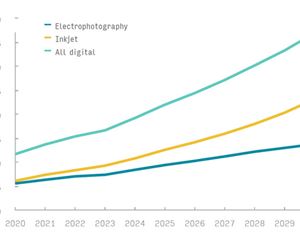Women to Watch: The secret to a strong economy — The Noel D’Cunha Sunday Column
In 2024, the Women to Watch Awards honoured 14 exceptional women who have been redefining the print, packaging and publishing segments in India. PrintWeek tries to tap the talents of the entire industry, in order to draw from the very best available. As we prepare for Women to Watch 2025, PrintWeek revisits their inspiring journeys, insights, and the impact they’ve made.
14 Jun 2025 | By Noel D'Cunha
The next revolution in print and packaging is already here. What impact will the women in print make? PrintWeek prepares to celebrate Women to Watch 2025, women who dare to reimagine the industry’s future.
In a male-dominated field, this is a rallying cry for women to step up and for men in leadership to lift others as they climb. If you know a woman making an impact in your factory, boardroom, or design lab, it is time to put her name forward.
Circa June 2024. In a brightly lit conference room in Mumbai, jury members discuss a carton mock-up job submitted as part of the entry, sparking a chain of conversations not about cost or print speed, but about impact. Rituricha Jain of Paperdom said in her testimonial, “We saved 17 trees with this single run,” as heads nodded in collective agreement. This is the new pulse of the Indian printing and packaging industry. It is thoughtful, progressive, and, increasingly, female.
Women to Watch 2025 is more than just an accolade; it is a statement. That leadership in the print and packaging world can be precise and powerful, sustainable and strategic, technical, and creative. The winners from 2024 stand as a testament to this shift. From factory champions to design visionaries, these women are not merely participating in the industry; they are reshaping it.
The new educators leading beyond the page
Rageshree Niyogi, director of product and marketing at Collins Learning, isn’t just delivering books — she’s driving change in classrooms. Her team has curated teacher development programmes, aligned with the National Education Policy of 2020. These programmes have touched 1.5-million educators and reached seven-million students. “Good teachers make good students, and consequently a better nation,” she said.
Workshops on Global Perspectives, storytelling initiatives and coding competitions are part of her broader goal to elevate teaching as a profession. “We need to make teaching aspirational, with pay parity and growth opportunities,” she insists. Her impact goes beyond the page; she’s reshaping how learning is delivered and respected.
The Global Perspectives workshop, for instance, demystifies the Cambridge Assessment International Education (CAIE) curriculum for teachers and empowers them to integrate critical skills like analysis, collaboration and reflection into everyday lessons. Her team of product managers conduct 70% of all training sessions, a model built on research, relevance and rigour.
Niyogi believes the print and publishing industry can invest in bridging educational gaps by supporting teacher training in resource-poor schools. "It is not enough to sell books. We need to enable educators to use them meaningfully," she said. In a country where the teaching profession is still undervalued, she envisions a transformation driven by pride, parity, and participation.
Power and precision shaping business futures
Priya Singh of Hachette India and Sheetal Dandekar of JB Pharma operate in distinct sectors, yet their operational acuity has led to transformative gains. Singh, a print engineer by qualification, pioneered Hachette’s shift to local print, a decision that cut costs, reduced carbon emissions, and boosted the bottom line. “Production is a function driven by staging, scheduling, and critical touch points,” she explained.
Her partnerships with Indian printers like Manipal Technologies (MTL) have been pivotal. Singh co-created an integrated print-logistics solution with MTL, avoiding unnecessary warehouse transfers and significantly improving delivery timelines. Books like The Casual Vacancy and Hachette’s Indian Detective Fiction series have become case studies in design, security, and logistics.
Dandekar has made waves in pharmaceutical marketing by identifying overlooked needs. Her campaign around kidney protection through Cilnidipine, a Japanese molecule, helped Cilacar become a trusted hypertension treatment in India. "Almost 40% of hypertensive patients forget their daily dose — the calendar pack was our answer," she said.
Her leadership extends beyond branding. Dandekar sees the future of pharma as data-driven and digitally integrated, with AI poised to accelerate drug research and patient engagement. "It’s no longer about just pills — it’s about ecosystems of care," she said.
On the factory floor with tech and tenacity
Srishti Kaushik’s turnaround of production timelines at Nutech Print Services — from 30 days to 15 — was no fluke. Her data-driven flowcharts, daily team huddles, and empathy for her shopfloor workforce led to a 30% turnover growth over three years. “Women don’t just work in procurement or quality. At Nutech, they’re in binding, folding, and even packing,” she said.
Kaushik began her journey optimising material usage, saving eight reams of black paper by recalculating layout plans. Her early initiative caught the eye of management and laid the foundation for her rise. Today, she begins her mornings on the shopfloor, connecting with operators to build trust and detect challenges early.
She’s passionate about making factories more inclusive. "We need to reframe factories not as muscle zones but as thinking zones," she says. Training, cross-functional planning, and daily production meetings have created a responsive and agile culture.
Mamta Garg of Brijbasi Art Press echoes that sentiment. She leads a team that designs children’s books for international markets, with in-house innovation from mock-ups to material sourcing. Her interactive theatre books allow children to express emotions through scripted scenes — a fusion of storytelling and therapy.
Designing tomorrow with advocacy and aesthetics
Priyanka Karyekar from Elephant Design reinvented Domino’s with a Gen Z aesthetic, turning boxes into experiences. “Functionality is essential, with aesthetics coming second,” she said. Her design strategy combines storytelling with pre-print diligence. She evaluates every element — type size, substrate choice, print test results — to align with the brand promise.
Karyekar believes in real-time collaboration with vendors. “We’re always on-site when final print production begins," she said. This level of involvement ensures that visual integrity and technical precision are never compromised. Sustainability conversations are also part of her briefing documents.
Meanwhile, Rituricha Jain is proving that a good story starts with the paper itself. Her Surat-based Paperdom uses banana fibre, cotton waste and bagasse to create high-performance, chemical-free papers. “We’re not just making paper — we’re crafting an alternative to deforestation,” she said.
Her team also runs a prototyping lab, testing ideas for premium stationery that doesn’t harm the environment. From international gifting clients to Indian CSR projects, Paperdom’s appeal is both ethical and aesthetic.
Sales and systems that scale with purpose
Bharti Aggarwal of NBG Printographic Machinery has made waves with her strategic selling. Under her watch, NBG commands over 35% of the paper bag machine market. Her blueprint includes clear SOPs, customer segmentation, and quality-first service models. “A seamless customer experience begins with understanding their pain points,” she said.
Her approach adapts to geography. In metros, she highlights innovation and customisation; in non-metros, it’s affordability and support. She sees sustainable packaging — especially paper bags — as the next growth wave, driven by both regulation and consumer preference.
Aggarwal’s team ensures that even semi-automatic machinery comes with training modules and post-installation troubleshooting. She credits their growth to a 360-degree approach: “We don’t just sell machines — we help businesses grow around them.”
Isha Deshpande of Trigon Digipack is redefining the supplier-client dynamic. Trigon’s ability to produce mock-ups, trupacks and commercial runs under one roof allows brands to test, tweak and produce faster. “Packaging is the suit your product wears. You want it to fit, flatter and stand out,” she said.
Academia and advocacy rooted in science
Suman Singh Gaikwad’s work on smart packaging — antimicrobial, thermal, scavenging — was honoured by the Food Safety and Standards Authority of India (FSSAI). Her pine needle-based biodegradable material, co-developed with IIT Roorkee, is packaging with a conscience. "We’re not just wrapping food. We’re protecting health," she said.
Earlier, her work in South Korea introduced her to real-time freshness indicators for perishables. Today, she applies that knowledge in Indian conditions, aiming to reduce food waste and improve rural logistics.
She’s also a mentor to young researchers, often guiding postgraduate projects in packaging science. Gaikwad is vocal about the need for India’s packaging policies to be informed by interdisciplinary research.
Meanwhile, in literary publishing, Poulomi Chatterjee of HarperCollins continues to champion quality and relevance. Her editing desk has launched bold new authors, explored experimental genres, and curated memorable narratives. "An editor listens more than they speak. And that makes all the difference," she said.
Building a movement of inclusion and infrastructure
In Chennai, Sangeetha Kannan leads KK Packaging — a company run by 90% women. From yoga to counselling, medical benefits to 5S productivity tools, the culture is holistic. “We transform uneducated, economically poor women into confident professionals,” she explained.
She’s built support systems for women across life stages — from menstrual health to menopause awareness. “It’s not just packaging. It’s community-building,” she said. Financial literacy, emotional well-being and skill-building go hand in hand at KK.
At Yoda Press, Arpita Das carries this torch in publishing. Her house actively recruits interns from diverse and marginalised backgrounds. “Our team is never more than five, but each one matters immensely,” she said. She offers editorial mentorship, career guidance, and — importantly — trust.
A visionary’s journey
Bina Sarkar Ellias, winner of the Outstanding Contribution to the Industry award, embodies the power of idealism. As publisher of Gallerie, a bi-annual journal launched in 1997, she has edited 50 issues that celebrate creative excellence across borders. Her mission, to blur political, religious, and cultural divides through art and literature, has earned global acclaim.
Ellias’s journey reflects a deep appreciation for diversity, from India’s rich cultural tapestry to global artistic movements. Her ability to weave these threads into a cohesive publication showcases editorial and design prowess. “Gallerie aspires for a unified world,” she said, a vision that resonates with Women to Watch 2025’s ethos of collaboration and progress.
Her story inspires nominees to think beyond profit, using their platforms to drive meaningful change. As India’s printing and packaging industry evolves, visionaries like Ellias will shape its cultural and intellectual legacy.
Why it matters
Women to Watch 2025 isn’t just a celebration of individual brilliance — it’s a platform to challenge norms. In an industry still dominated by male voices, this list is proof of concept. From editorial desks to die-cutters, innovation is not gendered. It’s earned. The Women to Watch 2024 awardees have earned it. And they’ve set the stage for the rest of us to follow. If you’re a woman in print or packaging — or looking to enter the industry — now is the time. The doors are open. The glass is already cracked. Step up. We’re watching.
Register now. The deadline has been extended to 15 July. For any inquiries or concerns, please get in touch with Avinash Bhakre at avinash.bhakre@haymarket.co.in or +91 99303 51282.












 See All
See All